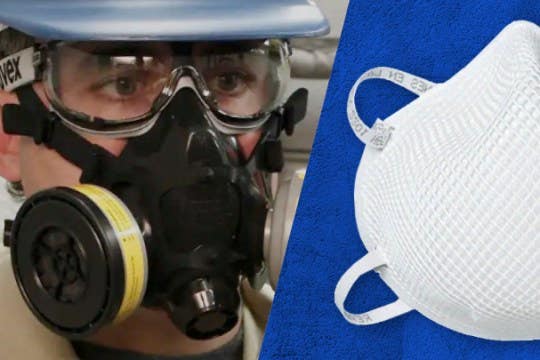
Respirator Mask Training: 3 Safety Tips
By John Heniff, Safety Writer, Magid




According to the Bureau of Labor Statistics, there were over 405,000 cases of exposure to harmful substances in 2020 that resulted in either illness or injury to workers. Typically, a worker’s last line of defense from being exposed to airborne and environmental contaminants is a well-fitting respirator. But between explaining how to keep their respirator in top condition and how to be aware of contaminants on the jobsite, covering all aspects of your respiratory protection plan can feel like an endless task for you and your team. To help, here are three easy ways you can get your workers on board for respiratory safety.


1. TEACH THE HIERARCHY OF CONTROLS FOR RESPIRATORY SAFETY
People internalize lessons better when they know the “why” behind the rule. Explain any hazard control measures you’ve implemented to make your team’s jobsite as safe as it can be, such as:
-
enclosing or confining the operation within a specific area
-
installing general or local ventilation sources
-
organizing work schedules to minimize the amount of time workers spend in hazardous atmospheres or only having a select number of workers in the area at a certain time
-
using less toxic materials during operations
Be sure to emphasize that their air-purifying or atmosphere-supplying respirator is their last line of defense after all other protection options have been applied to get them more invested in wearing it on the job.


2. TEACH WORKERS WHY AND WHEN THEY NEED A RESPIRATOR MASK
If you have a worker who thinks “what they can’t see, can’t hurt them,” they need to know the dangers that respiratory contaminants can cause. It often doesn’t end with coughs or sneezes. Teach during respiratory protection training that common symptoms of exposure range from dizziness and nausea to allergic reactions and respiratory distress that can potentially lead to death. Find an anecdote or a safety video to drive home that exposure can lead to chronic health conditions like COPD and certain types of cancer. Afterwards, you can walk around the jobsite and ask workers to point out all the areas and work processes that can create respiratory irritants.
Contaminants can be found in:
-
Dusts from concrete, cement, or silica
-
Fogs/Fumes/Mists from liquid solutions
-
Gases like carbon monoxide or carbon dioxide
-
Smoke from furnaces or welding operations
-
Sprays from paint
-
Vapors from petrol or ethanol
-
Fibers from asbestos
-
Microorganisms like viruses, mold, or bacteria
-
Microbials like pollen or dander


3. TEACH HOW RESPIRATORY PROTECTION WORKS
The key here is to show them, not just tell them. It’s important that workers know OSHA requires a medical evaluation and fit testing for filtering facepiece respirators in general industries. This is so everyone including the safety manager, the worker, and a licensed medical professional, can ensure the respirator will not create a hazard to the worker’s health while on the job. But once fit testing and medical evaluations have been completed, giving your workers the knowledge of how to put their PPE on correctly will make them more apt to wear their respiratory protection properly.
During training, when you’re going over how to properly don a respirator, instead of telling your group about wearing a respirator, take extra time to show them step-by-step how to put it on, take it off, and care for it properly. Let people experiment with how the equipment feels and what can go wrong by including time in your safety trainings to try different kinds of respirators your crew will use so they can see them and put them on before they step foot on the jobsite. You can use this same concept with cartridges and filters so your workers can see, feel, and install them in front of you for added confidence. This kind of hands-on experimentation also allows you to correct any mistakes they make in a safe environment, before it causes them to be exposed to a harmful substance on the job.
Download FREE Respirator Mask Training to show your workers how to use and properly care for their respirator.



